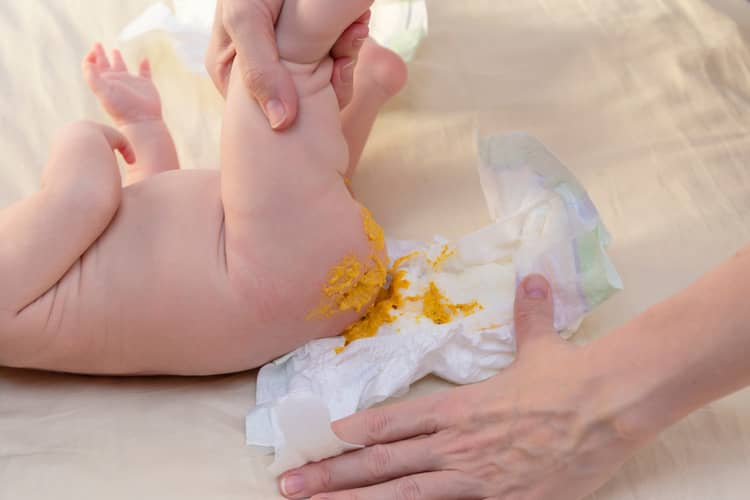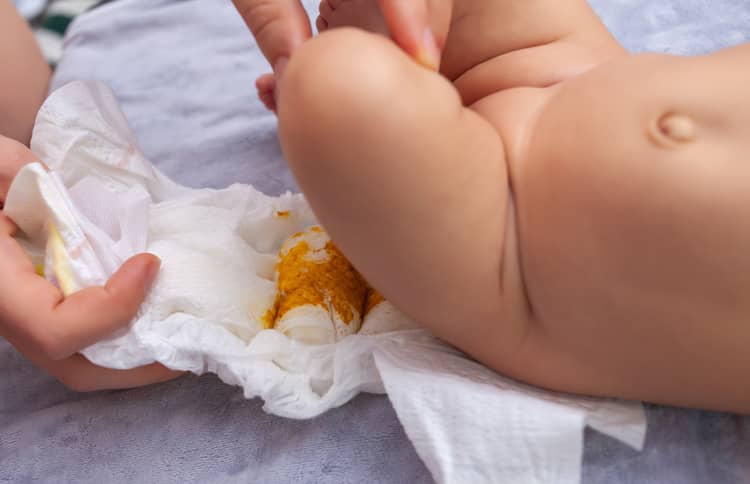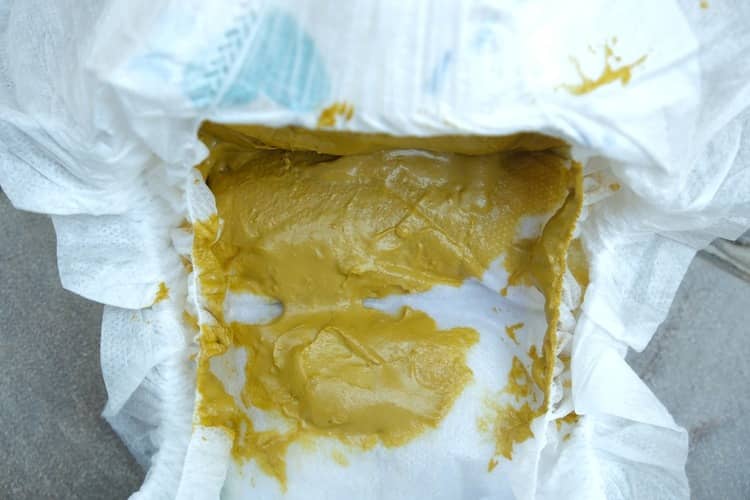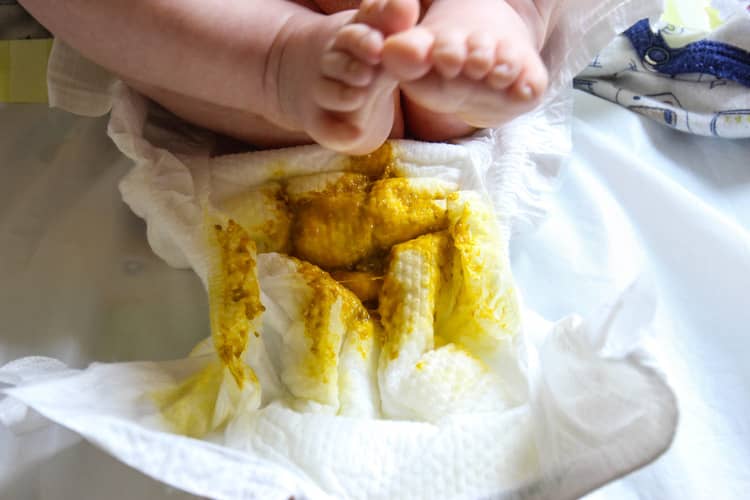
Newborn stool - green, black or liquid after formula?
Changing diapers is a daily routine for every parent of a small child. It's not the first thing that comes to mind when you think of the postpartum period, but it's a very important part of baby care.
Examining the color and consistency of the stool to make sure everything is fine will be a rule for you. With this, questions arise as to what normal stool should look like in newborns, what is the correct color and consistency of stool, and the ideal amount or frequency of stool. A change in the consistency, color or frequency of bowel movements can mean some dietary error, but it can also be a symptom of a disease.
Stool in a newborn
The color of a newborn's stool can be different, so you should know what each color means. However, not only the color of the stool is important, but also the consistency, amount, smell and frequency. A change in the stool can be caused by the child's age, because his digestion gradually develops and his diet changes. During the first six months, the newborn consumes only mother's milk, then complementary feeding begins, this can affect the color, consistency and smell of the stool. These changes are normal. However, the contents of the diaper should also be checked because a change in stool can indicate various diseases.

Color of stool in children
Black, green, yellow? Some stool colors are normal, some indicate a problem. The unusual color of the stool does not always have to be a reason for stress, it can be a natural process, a consequence of a change in diet. As long as the baby is happy and gaining weight, the color of the stool is not important, if his behavior changes along with the color of the stool, action must be taken.
Black stool in a newborn
The very first stool is called meconium, also known as smolka. You will encounter black stool during the first four days of a newborn at the most. It starts to leave on the first day and ends after the 4th day. Distinct black or green-black is formed by secreted amniotic fluid mucus, bile, exfoliated cells of the digestive system and skin, as well as water and fluid found in the intestine. The consistency is tarry, sticky, difficult to wipe off the baby's bottom.
Yellow stool in a newborn
After black, yellow stool with a creamy texture (can be greenish-yellow or even brown) most often comes. The color is typical for breastfed babies, it is influenced by mother's milk. If the child swallows more of it, the stool may be thinner. In the first 6 months, mustard yellow is a normal color and indicates a healthy stool.

Brown stool in a newborn
Light brown or brownish (orange or yellow) stool color is typical for children fed with infant milk. The consistency is firmer, reminiscent of peanut butter or cottage cheese. The child poops less often, usually once or several times a day. The exact color depends on the type of formula, those with a special formula can result in green baby stools.
Green stool in a baby
In the case of green stool, you should pay attention to the consistency, because it can be a normal, but also an unhealthy color of the stool. The green color can have many causes, the reason can be a relatively harmless cause, it can also be a serious problem.
It can be the result of using artificial milk containing iron, and therefore a normal condition. The stool should be thin to mushy with small lumps, reminiscent of mustard. Dark green stools may appear in the baby during the complementary feeding period. It signals that the child has eaten spinach or sorrel. The color is also affected by too many green peas. The green color can also be the result of oxidation during prolonged standing in the diaper.
Improper breastfeeding technique can affect the color. During breastfeeding, the baby primarily consumes foremilk with a high content of milk sugar, after which it reaches breast milk, which is richer in nutrients and fats. If the child drinks only foremilk, the milk sugar ferments in the intestines and the stool has a green color. This usually happens if the baby consumes only the front milk from both breasts, which is easier to access. The solution is to attach to the second breast only when the first breast is completely empty and the child has also consumed more nutritious breast milk.
The reason for the green color can also be the excessive consumption of milk and milk products, the use of medicines and vitamins, or green food containing iron in the case of the mother.
If a food allergy is behind the green stool, not only the color but also the consistency and smell of the stool will change. It will be stickier or foamier and smellier. Green stool can also be caused by an intestinal infection of the baby. The presence of a virus or yeast is signaled by green stools mixed with mucus.

Red stool in a newborn
The reason for the red color can be the consumption of preparations to replace iron or the consumption of beetroot, in which case there is no reason to worry. If the source of the red stool is blood, you should consult a pediatrician. It is important whether the blood is fresh or clotted (up to black). Fresh blood in the stool may indicate a ruptured rectum, which is associated with indigestion. In no case is bloody stool in a newborn a good sign.
White stool in a newborn
Even in this case, it is not a healthy stool color. If the feces are white, creamy or contain white pieces, this is the result of an excessive amount of fats that could not be absorbed in the intestines. These are problems with the liver, insufficient function of the bile. You should keep the stool sample, contact the pediatrician and show it to him.
The "smell" of a newborn's stool
Unfortunately, you cannot avoid smelling it. Stool naturally smells, so you will always notice whether it is a "good" or "bad" aroma. If it smells more than usual, it could be a problem. The smell is milder if the stool stays in the intestines for a shorter time. Acidic and stinky smell, e.g. means food allergy. The stool of a breastfed baby smells less strongly than the stool of a formula-fed baby. If you come across stool that smells more than usual, contact your pediatrician to make sure it is not a medical problem.

Stool frequency in a newborn
Whether the baby is breastfed or formula fed has a significant impact on the frequency of stool occurrence. Babies fed formula should poop at least once a day, often the frequency is higher - several times a day. Breastfed babies may poop several times a day in the first few weeks, but it's also normal if they don't poop for a few days. If the child feels well, is calm and does not refuse milk, he does not have to poop for 7 to 10 days.
In fed babies, the stool is harder (not hard, in the form of balls or watery) and less frequent, usually once a day.
Loose or hard - stool consistency in a newborn
Creamy stool, the consistency of scrambled eggs, cottage cheese or pudding - this is what a healthy child's stool should look like for the first 6 months. How to find out that it is no longer a creamy stool, but a thin one, and what if the stool is hard?
Loose stools in a newborn
Loose stools several times a day and even runny stools do not automatically mean diarrhea. However, you should know that babies are susceptible to it. If the stool is more liquid than usual, it may be diarrhea. Healthy stool has a creamy consistency, the thinness is absorbed into the diaper, it does not remain on its surface. There can be several causes of loose stools in a newborn. It can be food allergies, lactose intolerance, gastrointestinal infection, side effects of medications, consumption of large amounts of fruit or fruit juice, and also teething. In case the baby's loose stool persists for more than 24 hours, visit the pediatrician to reveal the exact reason for the problem.

Hard stool in a newborn
If the consistency changes from creamy to balls or harder oblong feces, it is a hard stool that signals a problem with the intestines. The child often has trouble pooping, hard stools are related to infant constipation. The causes can be food allergies, anatomical problems, dehydration, anxiety and thyroid dysfunction. When pooping, effort can be seen on the child's face, he has trouble pushing out the stool. Blood can often appear in it, as a result of ruptured blod vessels.
Mucus and foamy stool in a newborn
Neither mucus nor foamy stools may signal a problem. Mucus in the stool also occurs in healthy children. The baby may drool more, swallow mucus from a cough or runny nose. With excessive drooling, foaming of the stool may occur.
Experiences
Thin and yellow, green or yellow, darker brown - experiences with newborn stool are different. It depends on whether the child is breastfed or supplemented with artificial milk, what kind of milk is used, etc. In newborns, the stool should be dark to black at first and rather sticky, later rather watery yellow (breastfed babies) or brown to green (fed babies).
The most frequent questions - FAQ
The color of the newborn's stool is important, as well as the consistency and its frequency. We will be glad if you share your experience with this issue. In this way, you will help expectant parents and those who do not know how to deal with the color of their baby's stool.
What does green stool mean in a newborn?
What color should a newborn's stool be?
What does diarrhea look like in a newborn?
How often does a newborn poop?
What does gray stool mean in a child?
Pridať komentár





